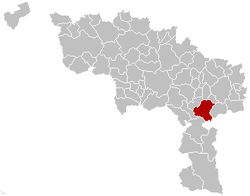Thuin
| Thuin | |||
|---|---|---|---|
| Municipality | |||

The old city and the belfry
|
|||
|
|||
| Location in Belgium | |||
| Coordinates: 50°20′N 04°17′E / 50.333°N 4.283°ECoordinates: 50°20′N 04°17′E / 50.333°N 4.283°E | |||
| Country | Belgium | ||
| Community | French Community | ||
| Region | Wallonia | ||
| Province | Hainaut | ||
| Arrondissement | Thuin | ||
| Government | |||
| • Mayor | Paul Furlan (PS) | ||
| • Governing party/ies | PS, MR | ||
| Area | |||
| • Total | 76.17 km2 (29.41 sq mi) | ||
| Population (1 January 2016) | |||
| • Total | 14,494 | ||
| • Density | 190/km2 (490/sq mi) | ||
| Postal codes | 6530-6534, 6536 | ||
| Area codes | 071 | ||
| Website | www.thuin.be | ||
Thuin (French pronunciation: [tɥɛ̃]) or [twɛ̃]) (Walloon: Twin) is a Walloon municipality located in the Belgian province of Hainaut. The Thuin municipality includes the old communes of Leers-et-Fosteau, Biesme-sous-Thuin, Ragnies, Biercée, Gozée, Donstiennes, and Thuillies.
This area was already used as a burial place in Gallo-Roman times, around the 2nd and 3rd century. The earliest name of the settlement, Thudinium Castellum, referring to a Roman fortification, is found on a 9th-century offering in the Lobbes abbey, which lists various neighbouring towns and related tithe duties. The village was a possession of the abbey of Lobbes and, together with the abbey, became part of the Bishopric of Liège in 888. The neighbouring Aulne Abbey, reputedly founded in the 7th century by Landelin, a repentant robber, was also made part of the Bishopric of Liège.
A century later, Prince-Bishop Notger had a defensive wall built in Thuin, which then became the westernmost of the 23 bonnes villes (or principal cities) of the bishopric.
In the following centuries, several battles took place in this frontier area. In 1048, Adalbert, Duke of Lorraine was killed at the Battle of Thuin by Godfrey III, Duke of Lower Lorraine. Many more battles followed between the County of Hainaut and the Bishopric of Liège, with Thuin caught in between. Despite the stronger defensive walls that were built in the 12th century and in the 15th century, Thuin was besieged several times. The Aulne Abbey, which had been given to Saint Bernard of Clairvaux in 1147 fared better and was even expanded several times in the 16th and 18th century. In 1654, the Spanish army under the Prince of Condé tried in vain to take Thuin. The good fortunes of the city were attributed to the intercession of Saint Roch, who is still commemorated in the annual St-Roch procession. Several 17th-century buildings, including the belfry, can still be seen today in the upper city. In 1675, the troops of Louis XIV took and occupied Thuin until the Treaty of Nijmegen in 1678. Like its neighbour Charleroi, Thuin went in turn to Spain and Austria.
...
Wikipedia




